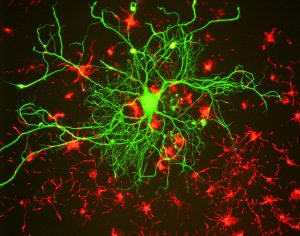Introduction to Neural Communication
What you’ll learn to do: identify the basic structures of a neuron, the function of each structure, and how messages travel through the neuron

Ever wonder how your brain actually works? What exactly is going on inside of your small, wrinkly mass while you read this text? In this section, you’ll learn about the basics of neural communication in the brain, which is the brain’s way of sending messages to and from different regions in order to relay critical information about your body and its surroundings.
Glia and neurons are the two cell types that make up the nervous system. While glia generally play supporting roles, the communication between neurons is fundamental to all of the functions associated with the nervous system. Neuronal communication is made possible by the neuron’s specialized structures, like the soma, dendrites, axons, terminal buttons, and synaptic vesicles.
Neuronal communication is an electrochemical event. The dendrites contain receptors for neurotransmitters released by nearby neurons. If the signals received from other neurons are sufficiently strong, an action potential will travel down the length of the axon to the terminal buttons, resulting in the release of neurotransmitters into the synapse.
Different neurotransmitters are associated with different functions. Often, psychological disorders involve imbalances in a given neurotransmitter system. Therefore, psychotropic drugs are prescribed in an attempt to bring the neurotransmitters back into balance. Drugs can act either as agonists or as antagonists for a given neurotransmitter system.
Learning Objectives
- Explain the role and function of the basic structures of a neuron
- Describe how neurons communicate with each other
- Explain how drugs act as agonists or antagonists for a given neurotransmitter system
attributions
Modification, adaptation, and original content. Provided by: Lumen Learning. License: CC BY: Attribution
Neuron in tissue culture. License: CC BY-SA: Attribution-ShareAlike
Cells of the Nervous System. Authored by: OpenStax College. License: CC BY: Attribution.

